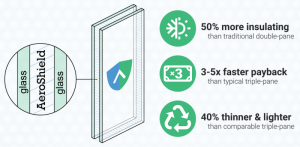by Mary Beth Gallagher, via Energy Post

Buildings represent one third of energy usage in the U.S., and that will be typical of similar economies around the world. The cost of re-fitting buildings to conserve energy is very high and can take decades. Specifically, 30% of the energy used to heat and cool buildings is down to the heat that either escapes or enters through windows. What if there was a way to control that heat flow without re-designing or replacing the windows? MIT’s Mary Beth Gallagher describes research there that has developed a smart light-sensitive film that can be added to the window. Its thermochromic microparticles go milky over 32°C, blocking up to 70% of solar radiation from entering through the window, giving a 30% reduction in cooling load. They’ve also created a high-clarity silica aerogel foam, placed between two panes of glass, that is 50% more insulating than traditional double-pane windows. As with all new research, scalalility is now needed to bring costs down, and the first steps towards commercialisation are being made.
Preventing energy loss in windows. Mechanical engineers are developing technologies that could prevent heat from entering or escaping windows, potentially preventing a massive loss of energy. By Mary Beth Gallagher , MIT News
In the quest to make buildings more energy efficient, windows present a particularly difficult problem. According to the U.S. Department of Energy, heat that either escapes or enters windows accounts for roughly 30 percent of the energy used to heat and cool buildings. Researchers are developing a variety of window technologies that could prevent this massive loss of energy.
“The choice of windows in a building has a direct influence on energy consumption,” says Nicholas Fang, professor of mechanical engineering. “We need an effective way of blocking solar radiation.”